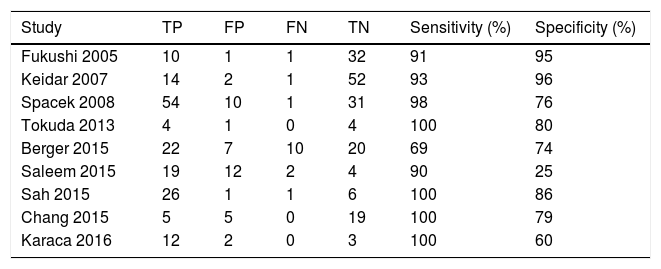Infection of large vessel prostheses is a rare but critical complication. The aim of this work is to assess the impact of PET/CT with 18F-Fluordesoxyglucose (PET-FDG) on the diagnosis of infection in our clinical setting.
Material and methodsThirty-five patients (38 scans) were evaluated for suspected prosthetic infection. A qualitative analysis was performed taking into account the distribution of the radiopharmaceutical, categorizing the studies as positive or negative for infection. Those with focal or multifocal deposits along the vascular prosthesis were considered positive, and negative if a homogeneous and diffuse distribution over the whole prosthesis was observed, or a total absence of uptake. A semi-quantitative analysis was performed using SUVmax and average SUV values, and a metabolic index was calculated (SUVmax of the graft / SUV SUV mean of the normal vascular pool). Diagnostic performance was compared with conventional angiographic imaging techniques (AngioTC).
ResultsThe PET-FDG study was positive in 20 patients, with a diagnostic accuracy of 84%. The 38 PET-FDG scans performed showed positive capture patterns (focal in 6, multifocal in 15, diffuse in 4) and negative pattern in the remaining 13. The sensitivity, specificity, positive and negative predictive values obtained for the PET-FDG were 95%, 89%, 90% and 94%, and for the AngioTC study 50%, 73%, 73% and 50%, respectively. The area values under the ROC curve were as follows: for the AngioTC 0.642 (not significant), and for the SUVmax values of 0.925 (p < 0.005), average SUV of 0.922 (p < 0.005) and for the metabolic index of 0.917 (p < 0.005).
ConclusionsThe PET-FDG proves to be a tool with high diagnostic accuracy in the infection of vascular prosthesis, both visual analysis according to patterns and semi-quantitative.
La infección de prótesis vasculares de grandes vasos es una complicación poco frecuente pero crítica. El objetivo de este trabajo es valorar el impacto del PET/TC con 18F-Fluordesoxiglucosa (PET-FDG) en el diagnóstico de infección en nuestro entorno.
Material y métodosSe evaluaron 35 pacientes (38 exploraciones) por sospecha de infección protésica. Se realizó un análisis cualitativo teniendo en cuenta la distribución del radiofármaco, categorizando los estudios como positivos o negativos para infección. Se consideraron positivos aquellos que presentaban depósitos focales o multifocales a lo largo de la prótesis vascular, y negativos si se observaba una distribución homogénea y difusa sobre la totalidad de la prótesis, o la ausencia total de captación. Se realizó un análisis semicuantitativo empleando los valores SUVmax y SUVmedio, y se calculó un índice metabólico (SUVmax del injerto / SUVmedio del pool vascular normal). Se comparó el rendimiento diagnóstico con las técnicas de imagen convencional angiográfica (AngioTC).
ResultadosEl estudio PET-FDG fue positivo en 20 pacientes, con una precisión diagnóstica del 84%. Las 38 exploraciones PET-FDG realizadas mostraron patrones de captación positivos (focal en 6, multifocal en 15, difuso en 4) y patrón negativo en los 13 restantes. Los valores de sensibilidad, especificidad, valor predictivo positivo y negativo obtenidos para el PET-FDG fueron de 95%, 89%, 90% y 94%, y para el estudio AngioTC de 50%, 73%, 73% y 50%, respectivamente. Los valores del área bajo la curva ROC fueron los siguientes: para el AngioTC 0,642 (no significativo), y para los valores del SUVmax de 0,925 (p < 0,005), SUVmedio de 0,922 (p < 0,005) y para el índice metabólico de 0,917 (p < 0,005).
ConclusionesEl PET-FDG demuestra ser una herramienta con una elevada precisión diagnóstica en la infección de prótesis vasculares, tanto el análisis visual según patrones como el semicuantitativo.
Article
If you experience access problems, you can contact the SEMNIM Technical Secretariat by email at secretaria.tecnica@semnim.es or by phone at +34 619 594 780.

Revista Española de Medicina Nuclear e Imagen Molecular (English Edition)












